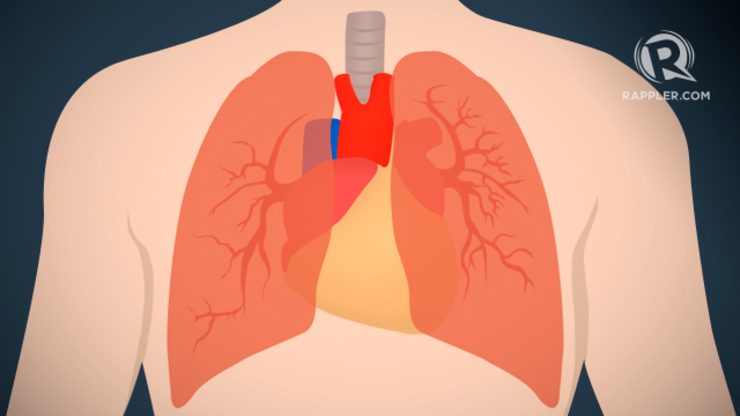SUMMARY
This is AI generated summarization, which may have errors. For context, always refer to the full article.

MANILA, Philippines – On Wednesday, July 2, Senator Miriam Defensor-Santiago announced that she has lung cancer.
She also said she has been diagnosed with Stage 4 cancer, but that she expects to be cured in 6 weeks through “chemotherapy [that] has been reduced to a tablet called molecular targeting.”
Here are some basic information about lung cancer – its prevalence, diagnosis, and treatment.
1. Lung cancer is the leading cause of cancer deaths in the Philippines and worldwide.
According to the World Health Organization (WHO), lung cancer claims 1.59 million lives around the world every year. In addition, there were 1.8 million new cases recorded in 2012, with 58% occuring in the less-developed regions. Lung cancer also has a poor 5-year survival rate of only 15%.
In the Philippines, lung cancer is the top cause of cancer-related mortality among men, and the third cause of cancer deaths among women (after breast and cervical cancer), according to the 2012 Globocan statistics of the International Agency for Research on Cancer (IARC).
2. There are two main types of lung cancer.
The most common type is non-small cell lung cancer (NSCLC), accounting for 85% of all cases.
The other type is small cell lung cancer (SCLC), which spreads faster, and is highly caused by smoking.
3. There are 4 stages of non-small cell lung cancer.
The first two stages are considered early stages of the disease, while the last two are advanced or late stages.
| Stage | Description |
| Stage I | The cancer is located only in the lungs and has not spread to any lymph nodes. |
| Stage II |
The cancer is in the lung and nearby lymph nodes. |
| Stage III |
Cancer is found in the lung and in the lymph nodes in the middle of the chest. |
| Stage IV | The cancer has spread to both lungs, to fluid in the area around the lungs, or to another part of the body, such as the liver or other organs (metastasis). |
4. Even non-smokers may get lung cancer.
A majority of lung cancer patients are smokers, with 70% of global lung cancer deaths caused by smoking, according to the WHO.
But non-smokers who have obtained it may have been exposed to substances like asbestos (for construction workers), radiation, pollution, and second-hand smoke. A person’s medical history – as well as his/her family’s – may also play a factor.
Changes in the genes or the DNA of lung cells may also lead to abnormal cell growth. It may either be inherited or acquired later in life due to exposure to substances mentioned above.
5. Like other cancer types, symptoms of lung cancer in its early stages may not be apparent.
According to the Lung Center of the Philippines, “there are no reliable blood tests that can detect lung cancer at an early stage.” Symptoms of the disease’s early stages are mostly non-specific, and may be initially disregarded by patients.
But individuals can undergo screenings and tests like sputum cytology, broncoscopy, chest x-ray, and biopsy to determine if a person has lung cancer.
For late-stage lung cancer, the following symptoms may manifest in patients:
- cough
- chest pain
- coughing out of blood
- chest infection
- malaise (feeling of general discomfort or uneasiness)
- poor appetite and weight loss
- shortness of breath
- drowsiness
- clubbing of the fingers (thickening of the fingertips with typical nail changes)
- bone pain
Early detection and treatment can increase the survival chances of a lung cancer patient.
6. Various treatments are available for lung cancer patients.
Depending on the stage or severity of the cancer, the following are common treatments:
- Surgery – the removal of the tumor, along with the diseased part of the lung
- Radiation therapy – the use of powerful x-rays to kill or shrink cancer cells at the specific site of the tumor in the lungs
- Chemotherapy – the intake of certain drugs (a pill or injected directly into the bloodstream) as part of a regimen to kill cancer cells
- Biological (targeted) therapy – the use of monoclonal antibodies, vaccines, and gene therapies to target cancer-specific processes
Biological or targeted therapy – the treatment mentioned by Santiago – is a relatively new approach to cancer treatment. It targets specific biological processes essential to the growth of tumors, unlike chemotherapy drugs which may affect even non-cancerous cells.
The said therapy may be given on its own or in conjunction with other treatments. Many of these therapies have been approved by the US Food and Drug Administration (FDA) to treat specific types of cancer, including lung cancer. – Rappler.com
Sources: Lung Center of the Philippines, Cancer.org, Cancer.gov, LungCancer.org, World Health Organization, International Organization for Research on Cancer, Roche.com, The Medical City, various news articles
Add a comment
How does this make you feel?
There are no comments yet. Add your comment to start the conversation.